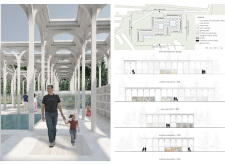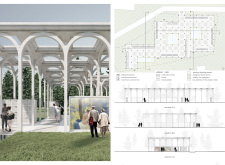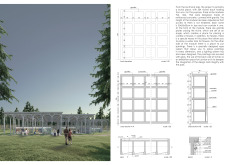5 key facts about this project
The Columbarium Art Design project is a contemporary architectural intervention situated in a natural landscape, likely within Latvia. It serves as a memorial space designed for the storage of cremated remains, with an emphasis on accessibility, inclusivity, and reflection. The architectural layout combines various functional spaces that cater to both individual contemplation and community engagement. By integrating natural elements with artistic displays, the project seeks to redefine the experience of remembrance.
Architectural Integration with Nature
A defining characteristic of the Columbarium is its seamless integration with the surrounding environment. The design utilizes a semi-open structure that promotes interaction between indoor and outdoor spaces, encouraging visitors to engage with the landscape. Water features and landscaped areas are strategically incorporated to enhance the meditation experience, providing a tranquil atmosphere conducive to reflection.
This project distinguishes itself from traditional burial sites by fostering a sense of community. The building accommodates art exhibitions that showcase local Latvian artists, inviting cultural dialogue and transforming the columbarium into a multifaceted space. This unique approach allows the project to function not solely as a site for memorialization but also as a venue for artistic expression.
Design Elements and Materiality
The detailing of the Columbarium further underscores its purpose and enhances the user experience. Key materials utilized include reinforced concrete for structural integrity, granite for the niches that hold urns, and wood paneling that adds warmth to internal spaces. The juxtaposition of materials is intentional, creating an inviting atmosphere while ensuring durability.
The niche design permits easy access for visitors and incorporates angled surfaces to support the placement of flowers and candles. Glass elements serve both protective and aesthetic functions, allowing natural light to permeate the interior while maintaining a connection to the external environment.
Visitors can explore the architectural plans and sections to gain a comprehensive understanding of how spatial arrangement contributes to functionality. An examination of the architectural designs and ideas reveals the thoughtful considerations that went into fostering a multi-purpose memorial environment.
The Columbarium Art Design project exemplifies a modern approach to memorial architecture. By prioritizing community engagement, artistic integration, and a strong connection to nature, this project offers an innovative solution that meets contemporary societal needs while honoring remembrance practices. To acquire further insights into this project, including detailed architectural plans, sections, and design considerations, readers are encouraged to review the project presentation.


























